Professional wrestling tells stories through physical expression, and the most fundamental unit of storytelling in wrestling is the maneuver, or more commonly, the move. A wrestler’s moveset, the unique and distinctive ways they fight in the ring, is an expression of their character: flashy or brutal or cerebral. Daniel Bryan’s Yes Kicks are crisp, sharp strikes to the chest, technical yet passionate. The Rock’s People’s Elbow is all braggadocio and theatrics, like taking the full impact of his charisma to the heart. Charlotte’s Figure 8 submission inherits her father’s famous Figure 4 move and adds her own brand of ruthless athleticism to it, arching her back to add extra pressure to her opponent’s body. Audiences learn which moves will finish a match and which are leading up to that climax, like commas building to a final exclamation point. Moves develop history in themselves; they can be bequeathed to a rising star; they can provide emotional depth to a match, a feud, a career. When Seth Rollins does a Pedigree, it’s not just a physical attack, but a reference to his onetime mentor, Triple H—perhaps a taunt, perhaps a tribute, it all depends on where their characters currently are. When Kenny Omega hits a lifting single underhook DDT and follows it with a belly-to-back inverted mat slam, the Japanese crowd goes wild because they recognize the Bloody Sunday and the Styles Clash, the finishing moves of former leaders of Omega’s faction. Moves are what makes a wrestler unique. A wrestler without moves is nothing, is nobody.
Well, not nobody. A wrestler without moves still exists, assuming he had them at one point in time. This is a field guide to the moves of Sami Zayn, one of the greatest wrestlers in the world, and a chronicle of how he lost them.
THE MOVESET OF SAMI ZAYN
The Barricade Moonsault. This is a move that Zayn added to his regular arsenal after he moved from NXT to the main roster in 2016, a move that would be hard to do elsewhere thanks to the extra-large padded barricades that WWE uses. When his opponent attempts to whip him into the barricade, Zayn instead pulls victory from the jaws of defeat and leaps atop the barricade, transforming his momentum into a moonsault that takes out his foe.
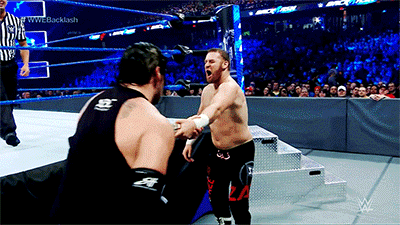
It’s a fundamentally defensive and reactive move, one that relies on Zayn’s opponent trying to hurt him and turning it into dazzling offense instead. More importantly, it’s a move that launches him right into the faces of the audience, larger than life, shattering the barrier between the performer and the viewer for a moment before sailing back and away. It never fails to get a reaction from the audience—amazement, wonder, delight. Here’s the first time he performed it on the main roster, in his very first singles match there against the Miz:
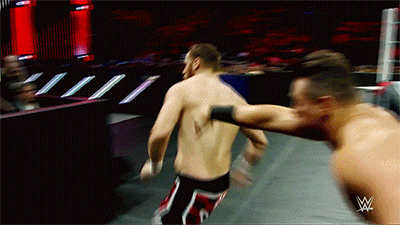
If you look at a still from the moment he lands on the barricade, you can see the visceral impact it has on the fans: mouths drop open in screams of shocked glee, the fan directly in front of him throws up her arm to shield herself. The older man on the far right raises his hands as if to try and help lift Zayn up somehow.
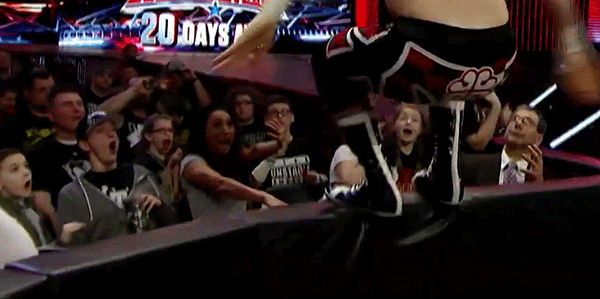
It’s innovative, spectacular, a move full of heart, designed to make the audience gasp and leap up.
It’s one of the first moves to be lost.
On Oct. 8, 2017, at Hell in a Cell, Sami Zayn leaps forward instinctively to save Kevin Owens from Shane McMahon as he falls from the top of the Cell. In his promos in the weeks after, it becomes clear that his impulsive action has snapped something in Zayn’s spirit. Finding himself allied with the man who has betrayed him, taken his title, even bragged about injuring him so badly he was out of action for months, it smashes his moral compass, leaving him with nothing but that alliance. He’s been broken under the weight of fans’ loving, demanding expectations, broken by Owens’ success and his own relative failure (as Owens gleefully points out just before his turn, six championship runs to zero!). Caring about the fans, about titles, about wrestling has become too painful, and so he bitterly explains to a horrified Daniel Bryan shortly after:

Within the fictional world of wrestling, caring is one of a wrestler’s main sources of power. You can care about a title, about the fans, about another wrestler—even spite and hatred are types of caring. To not care is to cut yourself off from that energy, and the foundation of Sami’s heel persona is that he doesn’t care.
A week after explaining this to Daniel Bryan, Zayn competes in his first singles match since his heel turn, against Randy Orton. In the middle of the match, he pulls out the barricade moonsault.
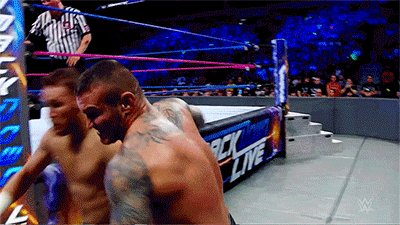
The audience reacts as it always does: you can hear startled giggles of glee and shrieks of delight as Zayn leaps away from them. They cheer involuntarily. None of which can mean anything to Sami Zayn’s character anymore. It’s not just that he’s a heel and heels aren’t supposed to elate the crowd, it’s that his character doesn’t care about their reaction anymore. Their happiness gives him no energy, so there’s no real reason to do it as opposed to any other safer, easier move. Why bother?
This match—Oct. 24, 2017—is the last time Sami Zayn does a barricade moonsault.
The Suicide Dive Tornado DDT. This is a move that few wrestlers but Sami Zayn do: When his opponent is in the right position, he takes a running dive through the corner ring ropes and into a tornado DDT.
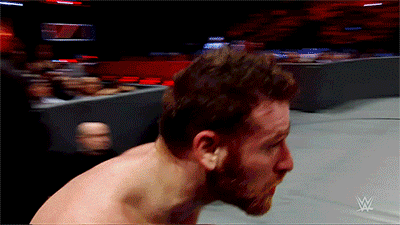
It obviously requires a great deal of skill and finesse to pull off this extravagant move. Because of its setup, it almost always includes a moment where Zayn realizes that his opponent is in the right place and pauses to gather his courage, a pause that inevitably is filled with a building roar of delight from the crowd, generating the anticipatory energy that powers him through the move.
Zayn does the suicide dive tornado DDT for the last time against his friend and ally Kevin Owens, when they’re forced to fight each other in February 2018, as tensions build toward WrestleMania.
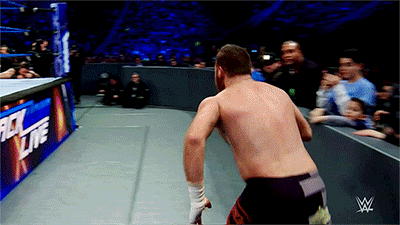
As he recovers from the move, you can see an agony in Zayn’s face that almost certainly is not due to simple selling: He’s limping his way to WrestleMania and his match against a returning Daniel Bryan, and will go out with double shoulder surgery shortly after that. In our present age of empty arenas, wrestlers have mentioned that ladder matches are the worst with no audience, because the lack of audience reaction means you have nothing to grant you the adrenaline to get through the pain. If Zayn’s character doesn’t care one way or the other about the reaction of the audience, there’s no borrowed energy for the wrestler to get him through that pain either. Feb. 6, 2018, is the last time he does this move.
The Rolling Arm Drag. Arm drags are a staple in many wrestlers’ movesets, but each wrestler performs them in ways that reflect their personality. Zayn’s are controlled chaos: His feet seem almost to slip out from under him as he sends his opponent flying and leaps back up.
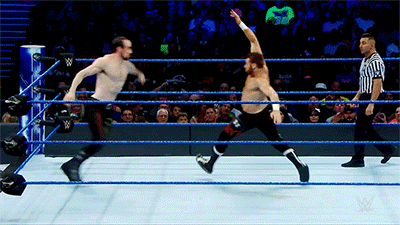
He usually finishes the move with a toreador pass behind his opponent’s back, disorienting them further.
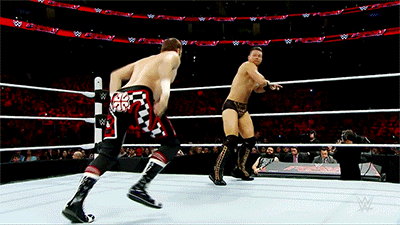
It gives the other wrestler a chance to show his startled shock at Zayn’s surprising agility, a moment to hint that the underdog might just have enough flair to pull this off. And as such, it doesn’t particularly fit the wrestling style of a wrestler who has despaired of his ability to win, an underdog who has lost his heart. He also does this move for the last time in that February 2018 match against Kevin Owens, a match that ended up coming to a no contest between the two longtime friends and rivals.
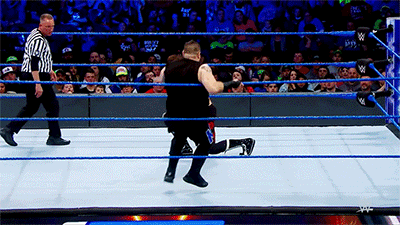
The Topé con Giro. A wild headlong dive over the ropes and out of the ring at the opponent, with a flip thrown in for good measure. A move of passion, intensity, and desperation. Like the suicide dive tornado DDT, Zayn usually pauses for a while before delivering it, to let anticipation build and the audience’s excitement grow to a fever pitch.
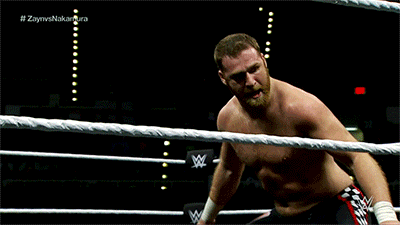
Even without that pause, it’s a move that is impossible to pull off quickly—there’s always going to be that slingshot on the ropes before the leap—so there’s always time for the audience’s energy to peak.
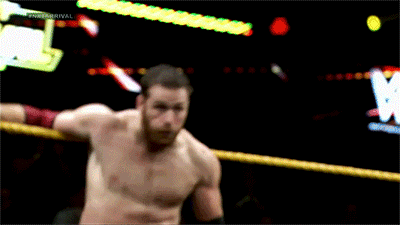
An idiosyncratic flourish of Zayn’s is that if his opponent moves out of the way, he’ll turn it into a fancy backflip back into the ring instead.
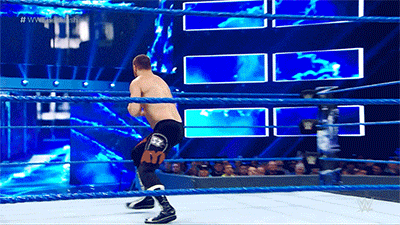
It’s a bit taunting, a little boastful: this is easy for me, buddy. A good reminder that even before his heel turn, Zayn always had a streak of braggadocio in his style, a touch of pridefulness and almost smug confidence in his abilities.
His last topé is against Kevin Owens again, because there’s no one in WWE, and few people in all of wrestling, who’ve been taking Zayn’s moves as long as he has. With their history—in WWE as well as out of it—Zayn will always get just a little bit more babyface shine when they meet up as heels, so it makes sense that the last iterations of some of his most spectacular moves would happen against Owens.
But here’s the thing: Remember that his friendship with Owens is based in part on his acceptance of Owens’ assertion that all of his style and all of his brilliance has gotten him absolutely nothing that matters—no cold, hard proof of superiority—in WWE. Zayn still has the braggadocio. It’s the solid, stable confidence underneath it that’s been eroded by his friend and by years of struggle. Without confidence in yourself, how can you go flying over the ropes into the void? The character doesn’t have that anymore to buoy him. So he stops doing it.
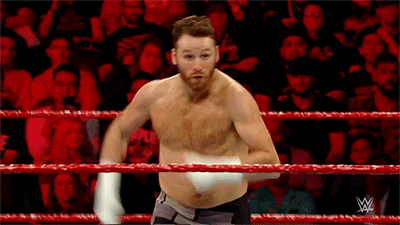
We see the topé for the last time on April 9, 2018, the Raw after WrestleMania, as the two men battle to earn a place on the Raw roster. Again, the agony on Zayn’s face after he crashes to the floor reminds us that a fair amount of what we call “selling” in wrestling may well simply be the wrestler allowing themselves to show the pain that is always with them. It’s only a few months after this that Zayn goes out for nearly a year with double rotator cuff surgery.
It makes perfect sense that a wrestler’s moveset shifts when their character does. Part of how wrestlers express the evolution of their character is through their signature moves, and it makes sense when a wrestler stops doing moves they are no longer physically capable of. But typically the wrestler starts using new moves to replace the old ones: Kevin Owens starts using the finishing move of Stone Cold Steve Austin, one of wrestling’s greatest tweeners, when he shifts away from being a heel. The Fiend picks up the mandible claw as a way to express the character’s horror roots.
Sami Zayn comes back from his months away on Raw following WrestleMania in April 2019, even more bitter and caustic than before. Remember how he told Daniel Bryan shortly after his heel turn that he “didn’t care anymore”? Well, if possible, he cares even less now. He doesn’t even care about winning titles anymore! When he’s asked why he’s never won a title on the main roster, he responds flippantly:
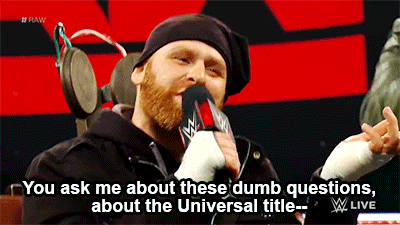
Here’s the thing: He still does care, and you can always see it in how loudly he yells he doesn’t. If he really didn’t care it might actually be better for him. But caring has become an unbearable pain, so he’s locked it all up tight, cutting himself off from what’s always given him strength.
His moveset remains barren because of it. You would think that he’d have some new moves to reflect his vicious attitude. But he doesn’t. One of the most creative minds in wrestling adds nothing and innovates nothing. He simply loses move after move, as if he doesn’t care enough to come up with new ones. The next months are like watching an artist throw away color after color in their palette, until all that’s left is monochrome.
The tornado DDT. This DDT requires Zayn to clasp the hand of his opponent, leap to the top of the turnbuckle, then swing into a DDT that brings his foe’s head slamming down.
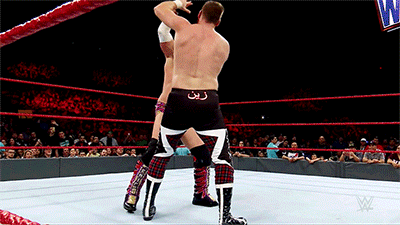
It’s one of his most graceful moves; a twisting, dancing pivot: the way his legs curve through the move, the way he shifts balance with such explosive suddenness. For a split second at the apex of the move, he leans out toward the audience, who can see and respond to the expression on his face.
During his time at NXT, WWE released a video shot in super-slow motion of the tornado DDT. Slowed down, the dance-like grace of the move becomes even more clear:
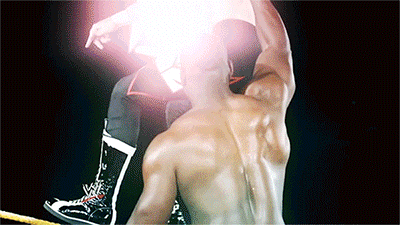
So does the more secret dance of wrestling: the way wrestlers work together to make a move look its best. The intertwined fingers lend support and stability. Zayn’s shoulder protects his opponent’s neck.
Zayn’s last Tornado DDT takes place on May 7, 2019, in a triple threat between Zayn, A.J. Styles, and Kofi Kingston for the WWE championship. It’s Zayn’s last title shot before he becomes a manager for Intercontinental champion Shinsuke Nakamura, and he does the DDT to Styles minus the run up the ropes:
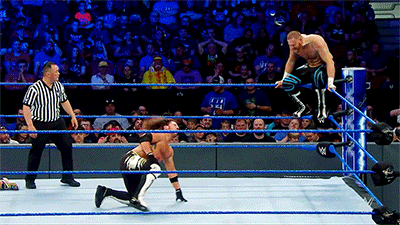
He loses this match, as he’s lost so many title matches before, each one driving him further into despair. We haven’t seen him do the move since.
The Blue Thunderbomb. The Blue Thunderbomb is possibly Sami Zayn’s most beautiful signature move, a belly-to-back spinning powerbomb full of frenetic energy which ends in a pin position.
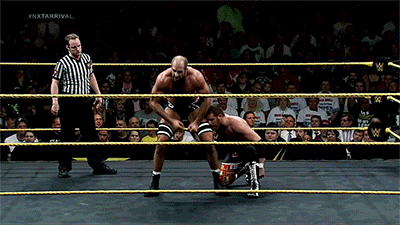
It feels like it should almost be a finisher, yet, notoriously, it has almost never actually gotten Zayn a win. The one televised time it did was against A.J. Styles in 2018, when somehow—like a miracle—Zayn’s faith in it paid off for once.
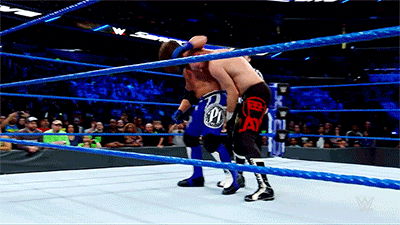
Here’s the perfect character touch about the Blue Thunderbomb: No matter how many times wrestlers kick out of it, the one person who is always, always certain it will finish the match is Sami Zayn. The way the move finishes in a pin gives him a chance to show his boundless underdog confidence, over and over and over, through every trial and defeat and dark moment. It symbolizes the hope that someday, despite all the odds, good will triumph over evil.
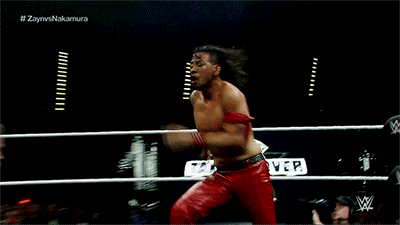
When Sami came back from his injury, I made a gif of him nodding in serene certainty as he tried to pin Finn Balor in his first match back, and I captioned it: “Sami Zayn has lost faith in everything else, but he will never lose his faith in the Blue Thunderbomb.”
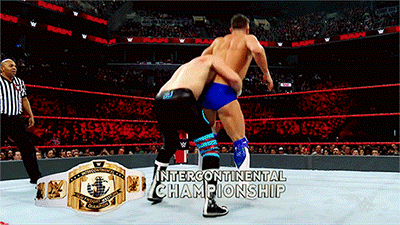
I was wrong. And more importantly, I failed to understand the implication that if Zayn did lose faith in his Blue Thunderbomb, he would be left with no faith at all.
The last successful Blue Thunderbomb Sami Zayn pulled off was against the New Day at the Stomping Grounds PPV in 2019. It’s actually part of a tandem offense move by him and Kevin Owens, in which Owens superkicks Xavier Woods into Zayn’s Blue Thunderbomb.
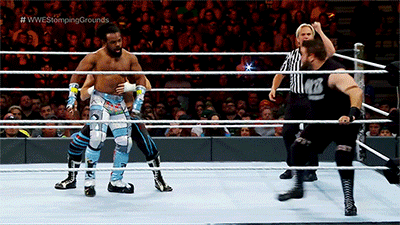
Woods kicks out, but Zayn and Owens do manage to win the match.
It’s the last win Zayn will see for nine months, until the day he wins the Intercontinental title.
The very next night on Raw, Zayn is in a non-title match with WWE champion Kofi Kingston, and when he tries to do the Blue Thunderbomb, Kingston reverses it into a pin and a loss for Zayn.
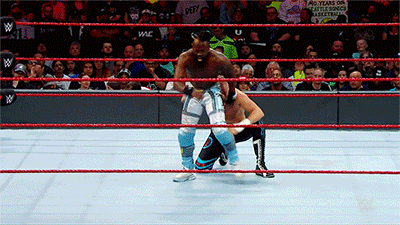
Attempting to do his own most beautiful, most distinctive move has cost him the win.
He stops doing the Blue Thunderbomb from that moment.
The night after that, on Smackdown, Zayn and Owens team up with Daniel Bryan and Erick Rowan to take on the New Day and Heavy Machinery. When Zayn gets tagged in, he doesn’t try a single one of his moves, he just frantically pummels his opponents, kicking and flailing. He’s got no wrestling left in him. On the ring apron, Kevin Owens gets increasingly frustrated. “What are you doing?” he calls in exasperation as Zayn taunts and bullies and doesn’t wrestle. Finally, as Zayn gets in way over his head and is clearly about to lose, Owens gives up and walks away. He’ll be traded to Raw shortly after, and Zayn will truly be on his own.
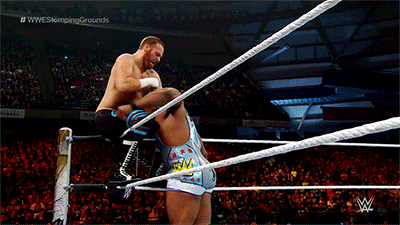
Zayn has six matches after that in 2019. Each one is under six minutes long, and Zayn doesn’t actually wrestle in a single one of them. There are no moves, just wild and ineffectual swings and kicks. He’s lost everything that ever made him distinctive, and he has nothing left but despair and rage. After he loses in the first round of King of the Ring to Cedric Alexander, he grabs a chair and takes out his frustrations—not on Alexander, but on the ring itself, attacking it in furious agony, as if it’s mocking him.
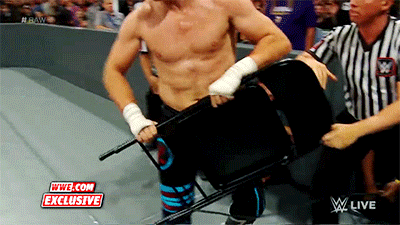
He won’t wrestle again for months. At the time it seemed like he might never wrestle again.
Instead, he attaches himself to Shinsuke Nakamura, the Intercontinental champion, holding up another man’s title, basking in the reflected glory of another wrestler’s skill. To those who love him, it’s a torment to see him give up wrestling. It’s anguish to watch him stripped to a bare shell of what he used to be, with no faith in his own skill. Even his overdue and long-awaited championship win has a painful edge, because he still doesn’t wrestle in it, not really.
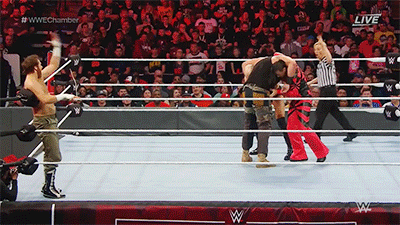
There’s the one move Zayn has kept, his Helluva Kick—one of his most simple, direct moves. He wins the championship off Braun Strowman with it as Nakamura and Cesaro hold him in place. At WrestleMania against Daniel Bryan, Zayn desperately stalls, dodges, and avoids his opponent, because he has nothing else. In contrast, Bryan pulls out every dazzling move in his repertoire: high flying moves, brutal submissions, savage strikes, technical mat wrestling, all the kinds of moves Sami used to do and can no longer. Eventually, Sami is reduced to tears of helpless rage, begging Bryan to stop, at which point Bryan looks down at him and says: “You did this to yourself.”
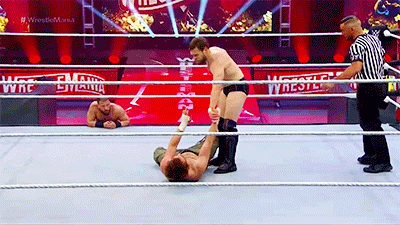
He doesn’t merely mean that Zayn is getting his comeuppance. He’s confronting Zayn with the horrible truth that he’s chosen, voluntarily, to give up every move that would have made it possible to fight Bryan. He’s never added anything new to his arsenal, there is nothing vicious or brutal or clever that reflects his “new attitude.” Well, maybe there is, after all—because his attitude is nihilism, and so it makes sense that he would end up embracing nothingness.
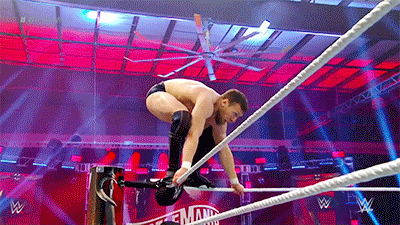
Sami manages to retain his title by a wild, off-the-cuff Helluva Kick that knocks Bryan out of the air. His wrestling reflexes, the ones he’s tried to ignore, take over and he pulls off one great move that saves the day for him. And then he disappears from television until a few weeks ago, emerging to proclaim himself the rightful Intercontinental champion and challenge the men who have reigned in his absence, A.J. Styles and Jeff Hardy.
He wrestles a full match without any help from outside interference against A.J. Styles a week before Clash of Champions—his first unassisted wrestling match since he lost in the King of the Ring tournament over a year ago.
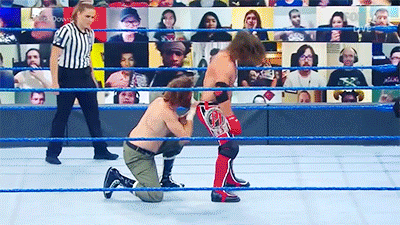
In that match, he actually does the Blue Thunderbomb again, for the first time in 453 days. The move starts almost instinctively: He’s bowed over, catching his breath and holding on to Styles, and as Styles moves away he grabs him and seems almost to do the move from muscle memory, without thinking. But by the time he completes the move he seems certain this will put Styles away, just like he always has in the past. Is it possible that some of his moveset is coming back to him? Now that he cares about something—proving himself the true Intercontinental champion—is it possible that he could start re-learning the moveset that made him so memorable?
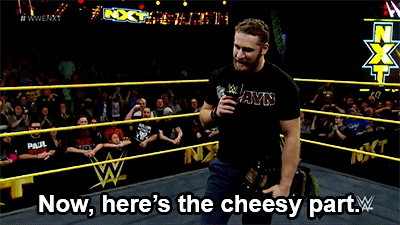
Can something precious, so thoroughly lost, ever be regained? After so long? Can Sami Zayn, who stumbled into his first main roster championship win through wiles and luck instead of skill, possibly learn to wrestle again? Just before his heel turn, Zayn wore tights emblazoned with a lyric from one of his favorite bands: “To resist despair in this world is what it means to be free.” Is there a chance that Zayn’s greatest opponent isn’t Braun Strowman or Daniel Bryan or even Kevin Owens, but despair?
Maybe Zayn simply isn’t capable of doing his signature moves anymore. It happens. Time catches up with every wrestler, and all we can do is enjoy their work while we have them. I cherish every moonsault Kevin Owens does on his battered knees, because one of them will someday be the last. I saw what might have been Tetsuya Naito’s very last Stardust Press with my own eyes, there in the Tokyo Dome with 40,000 fans screaming with joy, and I’m content with that. If we never see another Blue Thunderbomb because Sami Zayn’s shoulders can’t handle the strain, then that’s reality and must be borne.
But there’s another possibility. Maybe, just as wrestlers can express their character through their moves, Sami Zayn has used their absence to express his character’s slow slide into nihilism. One of the greatest powers of wrestling narrative is that it can tell a tale that spans months, years, even a whole career: a plot that unfolds in real time, pieced together by some combination of plan and happenstance. It doesn’t often come together just right, but when it does, there’s nothing like it. Maybe there’s a deliberate choice there. Maybe there’s a character arc being traced out, painfully and haltingly, through injuries and pandemics, across the years. Maybe it’s a story. And if it is a story about despair and hope, it would go something like this:
Once there was a brilliant wrestler with a moveset honed over decades to perfectly evoke joy, express hope, and create connection with the audience. But when he fell into despair, he gradually lost his faith in his own moves. His joy no longer strengthened him, his hope no longer lifted him, his caring no longer sustained him. As he sank further into bitterness, he gave up more and more of what made him himself, until he was just a shadow of what he used to be. Eventually, he gave up wrestling and tried to content himself with being the voice for others’ success. When his desire for glory finally outweighed his fears, he found himself ill-equipped to be champion without constant help. Despair has stripped him of everything he ever cared about.
How does the story end? The allies who helped him to finally achieve and hold onto the Intercontinental championship seem to have abandoned him. There’s no way he can hold his own against two of the greatest wrestlers in the world, A.J. Styles and Jeff Hardy, without using the moves he has no faith in anymore. Oh, he might be able to squeak out a win if he’s clever enough to let Styles and Hardy exhaust themselves against each other, if he’s cunning and sneaky and quick. It’s a ladder match, so all he has to do, really, is scramble up those rungs and grab the gold. But the title isn’t the final goal, not really. The real goal, the triumphant end to this chapter of Sami Zayn’s story, can only come if he learns to believe in his moves again, if he finds joy in wrestling once more—and if time and mortality and cruel happenstance will let it be told.
Maybe that’s the road to Sami’s redemption.
J.J. McGee teaches and attends wrestling shows in Japan when not posting gifs and commentary on Twitter as @Mithgifs.